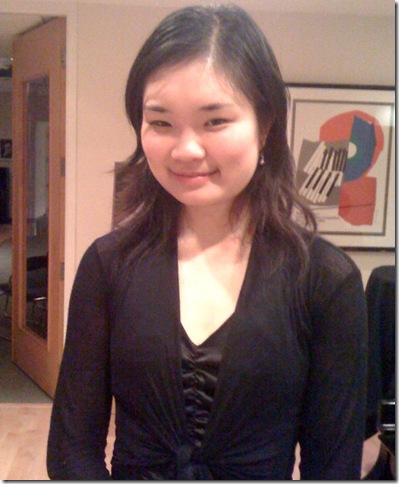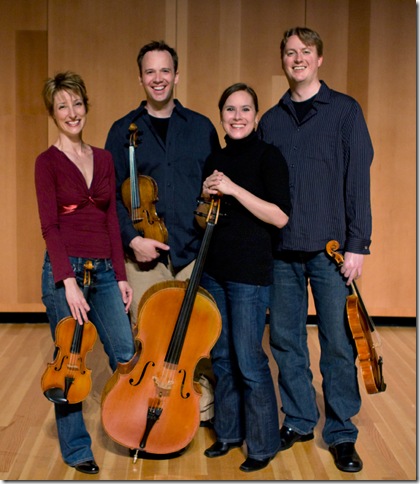Peijun Xu (Feb. 10, Steinway Gallery, Boca Raton)
If the concertgoing world doesn’t fully appreciate the variety that a viola can bring to a recital, that won’t be the fault of Peijun Xu.
The Shanghai-born musician performed two local recitals this week for the Kronberg Academy, an organization based in that German town near Frankfurt (the city that Xu now calls home) that helps accomplished violinists, violists and cellists build viable concert careers. The Kronberg has been raising money in Palm Beach County for its programs since August 2009.
Xu played recitals at Palm Beach Atlantic University’s Persson Hall on Wednesday night, and at the Boca Steinway Gallery on Thursday night. Her recital at the gallery was sparsely attended, but she and her accompanist, Spanish pianist José Menor, stinted not a bit, and the result was a rewarding evening of fine music, beautifully played.
The viola’s special sound can be tricky to realize, but Xu has a wide variety of qualities that she brings to the instrument, from a chocolaty darkness in the lowest registers to a breathy lightness that has a plusher, fatter sound than the same kind of passage on the violin. A good example of this came in the second work on her program, the Viola da Gamba Sonata No. 3 (in G minor, BWV 1029) of J.S. Bach. In the first two movements, her tone was focused and pure, and in the third the repeated notes of the main theme had a strong sense of lift that moved the music along smartly.
She has a good sense of Baroque style, and she and Menor worked very well together, smiling at each other throughout, and finishing phrases such as the trill suffixes in the second movement of the Bach with precision togetherness.
The Brahms Viola Sonata No. 2 (in E-flat, Op. 120, No. 2), originally for clarinet, also is a staple for violists, and indeed the music works well for the instrument. Here, too, Xu’s sound had purity and nobility from the first bars, and she handled the more virtuosic elements of Brahms’ late writing deftly. She demonstrated as well a welcome intensity in the minor-key sweep of the second movement, and the 32nd-note variation in the third movement had a lovely delicacy.
The second half of the recital showed more of the Romantic side of Xu’s art, beginning with the two Chansons (Op. 15) of Edward Elgar. For both of these pieces, Xu offered a bigger, more expansive sound, as if she were more relaxed, and the Chanson de Nuit, which she played second, benefited much from her digging more deeply into the strings. Xu is a highly physical player as well, swaying and leaning as she performs, often with her eyes closed tightly.
Her immersion in the music continued with a Chopin set: the posthumous C-sharp minor Nocturne (arranged by Yehudi Menuhin and Xu herself), and the celebrated E-flat Nocturne, Op. 9, No. 2, in an arrangement by Pablo de Sarasate. The tiny audience adored these intense readings, especially the E-flat, which could have used a bit more breadth in the cadenza before going to the brief coda.
The Paganini La Campanella (the Rondo movement from his Concerto No. 2 in B minor, Op. 7) that followed came off with great gusto and admirable accuracy, and demonstrated Xu’s considerable finger technique as well as the agility of her bow arm. The recital closed with a William Primrose arrangement of Astor Piazzolla’s Le Grand Tango, which she played with power and verve, swinging into the music with obvious enjoyment.
For an encore, Xu paid homage to her homeland with Fisherman’s Serenade, a Romantic-style arrangement by Li Guoquan of a Chinese folksong, which she played prettily.
After the concert, Xu talked about her concert career, which has included much playing of the viola concertos of Walton, Hindemith and Penderecki. Just 25, she has a fine career as a violist ahead of her, with the proviso that repertory for this beautiful instrument is always something of a challenge.
And so, this call to composers: Write some music for Peijun Xu. You won’t be sorry. – Greg Stepanich
Next up in the Kronberg Academy recital series is the Japanese cellist Dai Miyata, whom Menor also will accompany. Miyata’s recital is set for 7 p.m. Tuesday, March 8, at the Boca Steinway Gallery. Call 283-1815 for more information, or visit www.usfriendskronbergacademy.org.
***
Amernet String Quartet (Feb. 2, Stage West, Duncan Theatre, Lake Worth)
At the rear of the Duncan Theatre, there’s a gem of a space called Stage West, and on Feb. 2, that’s where the exceptional Amernet String Quartet performed works from the last three centuries to a full house.
First came the Haydn Quartet No. 67 (in F, Op. 77, No. 2), written in 1799. Here was
the ultimate in a form thought to have been invented by Papa Haydn and improved upon by others, notably Mozart, who dedicated six such works to the master.
The Haydn quartet, which was the last one he completed, opens with a strong cello voice in the first movement, beautifully played here by Jason Calloway. The Menuetto of the second movement opens with a throbbing , surging melody that is passed around each instrument. Then cello and viola engage in a duet with a very catchy tune, picked up by the first and second violins, who finish it.
An amusing two-note harmony, repeated once, ends the movement. The blend and balance of the third movement, marked Andante, was superb, and all four players gave of their best as they moved into the Finale with a forceful attack. The melody skipped along endlessly, closing with an unexpected suddenness. A fine performance, and one that left the audience in a good frame of mind.
The next piece on the program was six short adaptations of preludes from Shostakovich’s Op. 34 set for piano. These were transcribed by Yuri Vitenson, father to the Amernet’s principal violinist, Misha Vitenson, at the urging of his mother. Yuri Vitenson thought long and hard about adapting these piano works and decided that a string quartet would suit best. All are in the original key, and Misha Vitenson led his three colleagues with dynamism and incredibly strong expressive playing.
For me, it was over too quickly, and I wonder whether the elder Vitenson would consider doing all the other Shostakovich preludes in the set. They have great drama, and they are representative of many trends in 20th-century music.
The lone String Quartet of Claude Debussy, written in 1893, opened up the floodgates for the next 100 years in terms of a new approach in composing for the string quartet, primarily through exoticism. “We get to pull our instruments apart in this,” Callaway told the audience with a grin.
The first movement opens with what sounds like an express train racing down the rails. It builds and builds until it stops, and one feels as if one has fallen off a cliff. Ending with rising crescendos, the music fades to nothingness. Plucked strings begin the second movement with tuneful melodies rising and falling until they return to plucked strings of the opening.
A soft, elegiac mood starts the third movement, which was led by violist Michael Klotz, who played exquisitely, producing some lovely romantic sounds, warm with expressiveness. At the last, the express train returns with edge-of-the-seat sounds reminiscent of music in a film noir. A real sense of urgency distinguishes itself in this movement, which has a triumphant ending. Rapturous applause greeted the magnificence of the Amernet’s interpretation, and deservedly so.
I have heard many string quartet groups over the years, few as business-like or intense as these four talented musicians. No histrionics attend their playing like some I’ve encountered. Their sound has a strength and vibrancy unique to them, and it was a rewarding experience to see and hear such fine artists at the top of their game. – Rex Hearn
***
Fry Street Quartet (Jan. 30, Society of the Four Arts, Palm Beach)
Performing one of the last extraordinary string quartets of Ludwig van Beethoven is always a special event, but it doesn’t hurt to explain to an audience just why that is.
Rebecca McFaul, the second violinist of the Fry Street Quartet, took her audience at the Four Arts on Jan. 30 carefully through the seven movements of the C-sharp minor quartet (Op. 131), demonstrating along with her colleagues various sections of the work and generally demystifying it. It was carefully done, and no doubt much appreciated, though the audience was already on the quartet’s side before it began to play.
The Fry Street is a fine professional quartet, based now at Utah State University, and also a veteran of the Beethoven cycle, and the foursome offered selections from both ends of it at the concert. Opening the afternoon was the very first quartet (in F, Op. 18. No. 1), and the Fry Street delivered a masterful performance of this early work.
The first movement had plenty of tightly coiled energy while being light on its feet; Beethoven’s motifs climbed and yearned like they should, but without overdoing it. First violinist William Fedkenheuer played with intensity and feeling in the long-breathed second movement, but the deliberate ritards at the ends of his solo figurations before leading back into the tuttis were somewhat on the stagey side.
The trio of the third movement had a good sense of shock and vigor, and the easy briskness of the finale was a good compensation for slight ensemble miscues here and there in the three-note figure that answers the triplet runs in the main theme. All in all, a strong performance, and one with an appropriate early-wine style.
Samuel Barber’s only String Quartet (in B minor, Op. 11) is too rarely heard in its original form, though the slow movement is known around the world as the Adagio for Strings. The Fry Street’s reading of the Barber was much like its early Beethoven in that it was clean, thoroughly prepared, and well-executed.
The first and third movements were suitably peppery, and the restraint with which the quartet played the celebrated Adagio made it more affecting.
The Op. 131, which occupied the second half, requires a steady narrative line as well as strong musical chops, and the Fry Street has these. It showed good ensemble throughout, notably in the final movement, with its many rapid changes of dynamics, its gruffness and bluster, and its sudden shifts in mood and tempo.
No part of this work got an exceptional reading, and the group’s steady control of its interpretation came at the cost of some emotional temperature. But then again, the boisterousness of the fifth movement brought generous applause from the audience, which showed that this admirable foursome had succeeded in keeping the crowd’s attention through one of the most demanding works in the literature to play and hear. – G. Stepanich


